“I don’t think of the characters in GUN as bad so much as flawed” Jack Foster talks super villain motivations in Gun
 This summer has been all about villains thanks to Suicide Squad and co. However Jack Fosters’s Gun is about more than just another bunch of cool anti-heroes. One of our top 30 ComiXology Submit titles of 2015, the first arc is set to reach an epic conclusion this week with the release of issue #3 and so we catch up with ‘The Villainist’ himself to find out more about his motley band of villainous heroes who go on the run after a superpowered bounty is placed on their heads.
This summer has been all about villains thanks to Suicide Squad and co. However Jack Fosters’s Gun is about more than just another bunch of cool anti-heroes. One of our top 30 ComiXology Submit titles of 2015, the first arc is set to reach an epic conclusion this week with the release of issue #3 and so we catch up with ‘The Villainist’ himself to find out more about his motley band of villainous heroes who go on the run after a superpowered bounty is placed on their heads.
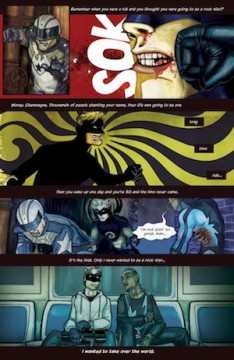
Gun is about super villains, rather than heroes, what was it that inspired you to go down that avenue rather than a traditional hero book? Was it a desire to do something fresh or just the lure of the dark side?!
JF: I think it has more to do with relatability. Stories about heroes tend to be aspirational; just speaking for myself, I‘m not sure I can identify with whatever it is that motivates Superman to get out of bed and do what he does day after day. Bruce Wayne, Tony Stark; those guys are trust fund kids. The characters in Gun, I don’t think of them as bad so much as flawed. They’re a little lost, a little messed up, they make poor decisions, in some cases they’re in over their heads. It’s really more about how the arrow misses. With Trevor, what I wanted was to take a guy who’s really at the bottom; he’s got the lamest power, he’s a joke to his peers, the deck is stacked against him. How does this guy take over the world?
It almost feels more like a crime noir than superhero book, was that intentional and what comics inspired you when coming up with the look and feel – it reminds us of everything from Watchmen, to Powers, to Alex Ross’ Kingdom Come!
JF: It’s funny you mention that because one of the questions the current story asks is what’s the difference between a criminal and a villain and I think the answer has to be more than just ‘well, one of them wears a mask’. The capes and the death rays are fun, but I think it’s a good test of how solid the story is if it still works without all that, otherwise all that extra stuff is just a gimmick.
I wouldn’t say it was an inspiration necessarily but there was this movie, The Place Beyond the Pines, and it told this really small stakes tale about petty criminals, but the storytelling was incredible. When you’re working that small the emotions just get bigger in comparison. Comics often forget that, when you’re facing these galaxy-smashing threats, you and your little life and your little concerns seem so small.
The auction scene in issue #1 is one of our favourites and feels like such an integral part of the story, was that something which you came up with early on in the writing process? The night club scene feels rather similar were these set pieces which you built the story around perhaps?
JF: I kind of knew from the outset that the auction was going to be the money shot so while I was working on the art for the first issue, to warm up I would sketch out a character or two so when I finally got to drawing that page I had like a couple dozen or so characters to populate it with. Believe it or not each one of them has a name and some sort of a backstory. Parma Violent, Jellyfish, the Lostronaut, Jonny Panic… those pages were an absolute blast to work on.
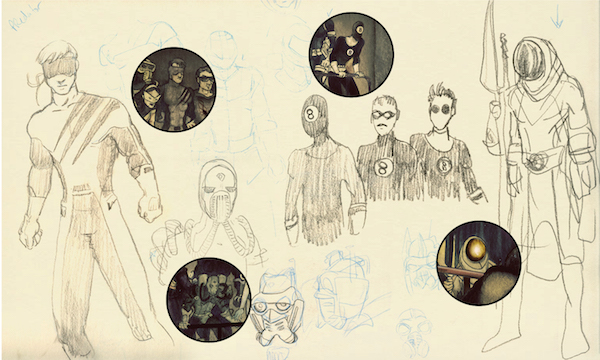
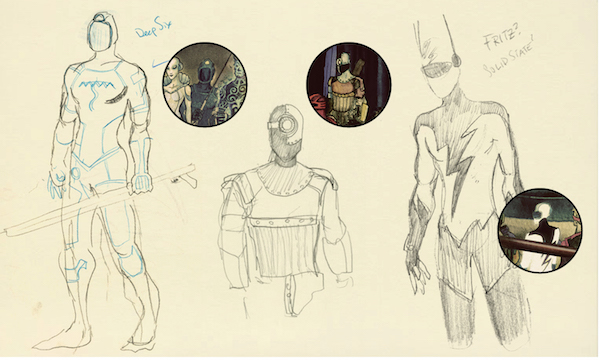
You do a great job of making the characters feel really grounded, especially Olive – were you ever tempted to make things a bit more flamboyant and campy or was it always important to be more down to earth (you manage to get a brilliant balance of being ‘adult’ but without resorting to blood and guts and violence – even though there is some of that!)
JF: It was really important to me to get Olive right. What a character like Olive Armstrong does is invites women readers in and I think for a long time they’ve been poorly served by comics. We’ve got our own Madonna/whore complex; you’re either the Strong Female Character or the Bad Girl, the Wonder Woman or the Catwoman. I think if you look, the real revolution in contemporary writing has been women characters (from Bridget Jones to Carrie Bradshaw) who can be flawed, who make mistakes and aren’t punished for them – you know, like get flung on a pair of train tracks, or stitching a red A on their chest. So with Olive, I wanted to make a flesh and blood woman, with complicated emotions, who has her own agenda but is also her own worst enemy.
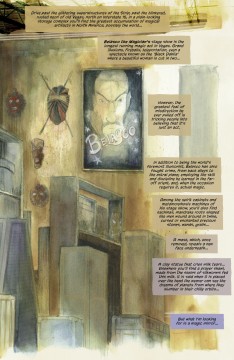
You seem to really enjoy the world building – creating back stories and insecurities for your characters, rules of being a villain plus the various slang and phrases they use – did these evolve as you produced the script or did you set them all out beforehand?
JF: It’s a little like the Butterfly Effect, right? Once you invent a character who can fly, or shoot eye lasers, how does the world buckle and warp around that? I had the character for Trevor almost from the start, but I was kind of skittish about naming the comic after him. It’s a little like when an album also has a song that’s the name of the album, don’t you think? And I was listening to the Siouxsie & the Banshees cover of the John Cale song ‘Gun’ it really described the kind of world I was trying to make, and I thought, Oh! Have the bad guys call themselves ‘guns’ … you know it’s kind of sideways, it’s not too on the nose, and I thought maybe I’ll call the first arc ‘gun’ and then it was obvious, no, dummy, call the book ‘Gun’.
Can you tell us a bit about your artistic process? Gun looks almost hand painted – is it? Or do you work digitally? Did you settle on the style for Gun very early on or did you try different looks for it before setlling on the painted approach? How long does each issue take?
JF: Gun is hand painted. Each page starts off on a sheet of watercolor paper, I scan that and there’s a bunch of work done in Photoshop, special effects that are hard to achieve with paint, that kind of thing. I wanted it to look like those great old Epic-era books, very analog. The industry kind of zigged when I thought it would zag back in the 90’s. Printing techniques were making it possible to reproduce fine art mediums like painting and mixed media and you were less constrained by the old model of keeping penciling, inking and coloring separate processes. There was amazing stuff coming from Bill Sienkiewicz, George Pratt, Kent Williams. And then digital came in and really took over. It’s a lot like movies with practical effects vs. CGI. Which isn’t to say that I don’t love what you can do with digital art, there’s certainly room for both, but as for where I plant my flag, I’m pretty old school. A nice by-product of that it gives the book a distinctive look.
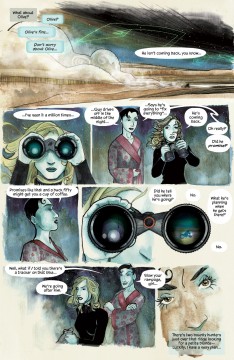
The book also has a beautiful sense of design, especially in the cover, how important is that for you? And how difficult is it to create a book which stands out from the crowd in terms of originality?
JF: Professionally, I worked as a designer, so I kind of figured if the story and art were terrible at least I’d get points for the typography. It’s a funny story but when I first started taking my portfolio to cons, the art didn’t make much of an impact but I always got complemented on my business cards, which, on the flight home or whatever, is really cold comfort. Making a book that stands out, I don’t know, I feel for a long time the wall I felt like I was banging my head against was ‘why can’t you make this more like everything else.’ My style is eccentric, no one particularly wants you to ink or paint your own work, if I had a nickel for every time someone told me to just digitally color the book. I think it comes down to stubbornness to say, in the end, just make the kind of book you want to read. Then you make at least one person happy, I guess.
Will we see more from the world of Gun? Are you working on anything else at the moment?
JF: Yes. The next issue, (#4) kicks off a new story arc. It’s part Cannonball Run, part Death Race 2000. There’s this underground extreme sport where teams of villains paired up in cars try to get this bomb called the slaughterball across one of the end zones on either side of the continental U.S. before it blows up. It should run about 6 issues it’s got a huge cast (that shrinks sizably each issue) and lots of moving parts. It’s ambitious but I think the first 3 issues were a real crash course in how to make comics and I feel like I’m finally kind of finding my groove.
And finally, could you sum up Gun in 5 words?
JF: Bonhomie among Ne’er-do-wells
You can purchase Gun #1-3 from ComiXology for £1.49 per issue and find out more about future issues via the Reckless Eyeballs tumblr


